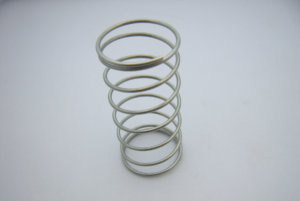After the completion of spring manufacturing, problems such as deformation or dimensional deviations often arise, necessitating the adjustment of the spring’s shape and dimensions to ensure it meets specified requirements and standards. This article delves into the influence of the correction process on spring in detail.

The Influence of the Correction Process on Spring:
The correction process is a crucial step in spring manufacturing, directly impacting the spring’s dimensional accuracy, performance, and service life. Firstly, due to the potential errors in the spring’s free height, perpendicularity, pitch, outer diameter, etc., after manufacturing, mechanical correction through compression or stretching of the spring ensures that it meets the prescribed dimensional accuracy. Secondly, adopting a cold correction process, where the spring is compressed or stretched at room temperature, can appropriately enhance the spring’s hardness and elasticity, ensuring its stable operating performance. Furthermore, during the manufacturing process, internal stresses generated within the spring can affect its lifespan. Thermal correction, where the spring’s shape is adjusted through heat treatment, serves to eliminate these stresses.
However, the influence of correction processes on springs is two-sided. On one hand, it can enhance the dimensional accuracy of springs; on the other hand, it may also adversely affect or even damage the spring’s performance. Firstly, correcting the spring may alter the microscopic structure of its material, thereby affecting its elasticity. Secondly, excessive correction can damage the material structure, impacting its service life. Additionally, improper correction can cause the spring’s load characteristics to deviate from the design values, affecting its operational performance.
Therefore, to minimize the impact of correction on springs, it is crucial to control the correction force, speed, and number of corrections. For instance, excessive correction force can affect the spring’s deformation, too fast a correction speed can impair its elasticity, and too many correction cycles may damage the spring, reducing its service life.
Furthermore, correction processes are labor-intensive, time-consuming, and can increase manufacturing costs. Hence, selecting appropriate correction equipment is essential to ensure precision and efficiency during correction. Additionally, based on the material properties and usage requirements of the spring, it is necessary to reasonably set parameters such as correction force, speed, and number of corrections to reduce costs and ensure spring quality.
Conclusion
In conclusion, correction processes play a vital role in spring manufacturing. By precisely controlling the correction process during actual processing, not only can the dimensional accuracy of springs be improved, internal stresses eliminated, and elasticity enhanced, but also the service life of springs can be extended, ensuring stable operation. However, correction processes have limitations, as excessive correction can damage springs, necessitating strict control over the correction process.
Why Choose Sino Special Metal?
Thank you for reading our article and we hope it can help you to have a better understanding of the influence of the correction process on spring. If you are looking for spring steel manufacturers and suppliers online now, we would advise you to visit Sino Special Metal.
As a leading supplier of spring steel from Shanghai China, Sino Special Metal offers customers high-quality spring steel products such as 65Mn Spring Steel, 50CrV4 Spring Steel, 9260 Spring Steel, and SUP9 Spring Steel.




